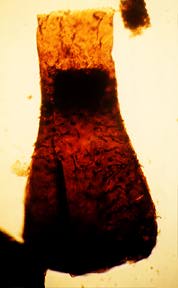
(Lower Cambrian-Lower
Devonian)
Chitinozoa
are extinct marine microscopic fossils with organic-walled skeletons called
tests or vesicles, measuring 0.05-2.0 mm in length and resembling miniature
flasks. They are of uncertain affinity but are treated taxonomically
as animals, probably monophyletic. Chitinozoa originally occur as
single tests. Some scientists believe that Chitinozoa are marine metazoan
egg capsules, similar to gastropod egg capsules. This is based on
their frequent occurrence in aggregates or in chains, joined in an aperture-to-base
formation. This linear assemblage is widespread in all the common
genera. The Chitinozoa
were named after their chitinoid appearance in 1931 by the German micropaleontologist
Alfred Eisenack, who discovered multiple genera in 1929. Chitinozoa
are classified according to the overall shape of the test, ornamentation,
the essential qualities of the basil margin, the tendency to occur in chains,
the nature of the internal prosome-operculum structure, and size.
More than 50 genera and 500 species have been described.
Chitinozoa
appeared during the late Cambrian, diversified rapidly in the Ordovician
and Silurian Periods, and became extinct toward the end of the Devonian. Chitinozoa
are generally accepted to be planktic. This is supported by their
broad geographic distribution and occurrence
in a wide range of depositional environments. Moreover, they are
preserved in most types of marine sedimentary rocks. These characteristics,
in addition to their rapid evolution, make chitinozoans for both regional and intercontinental stratigraphic correlation.